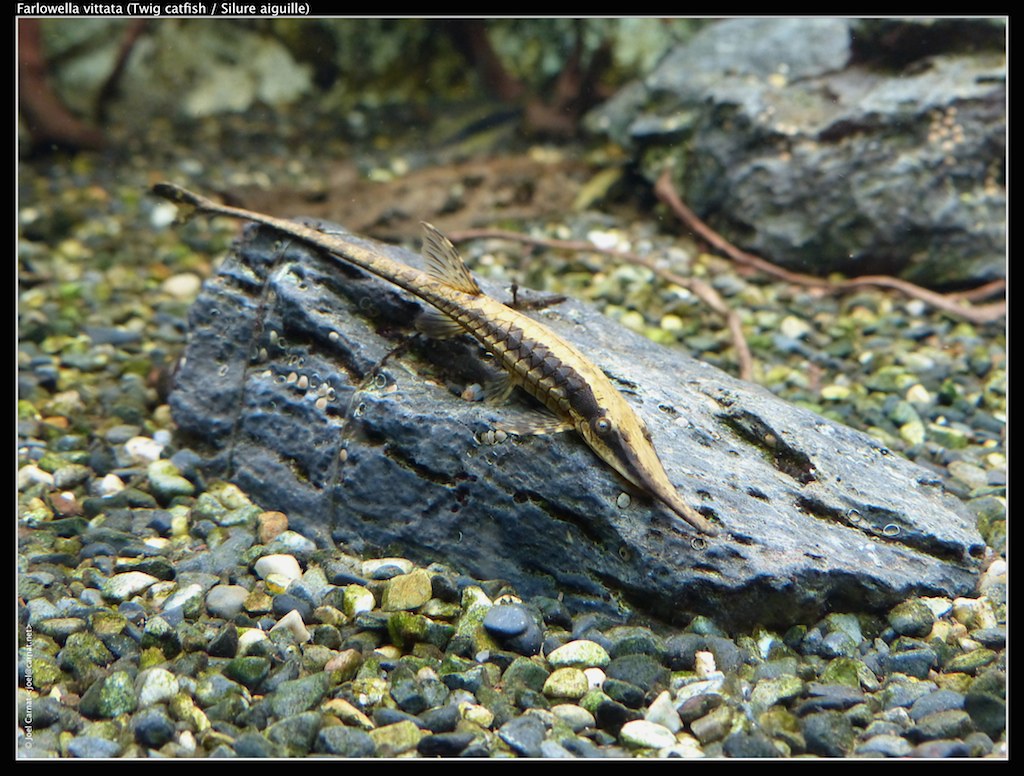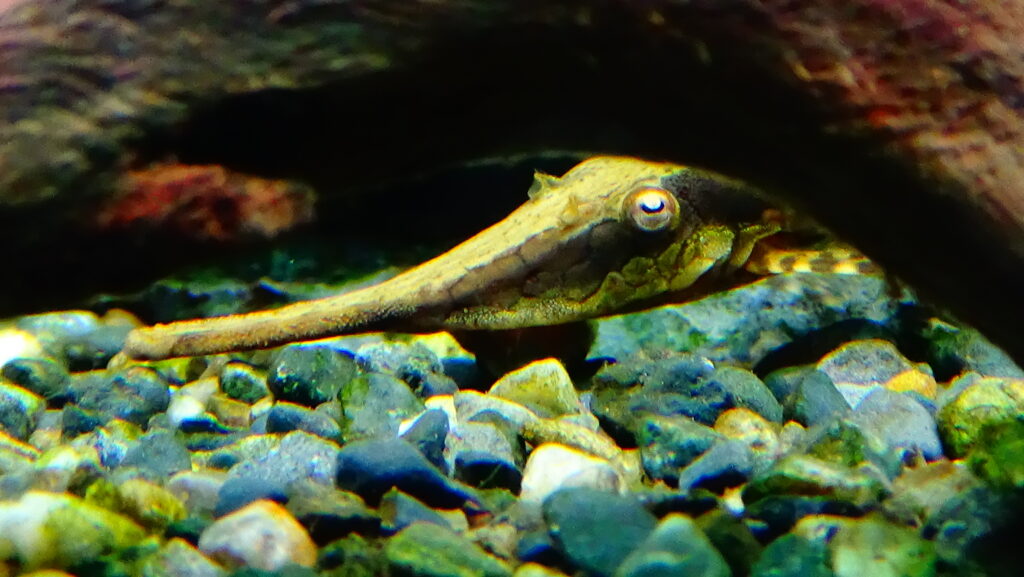Twig Catfish
Belonging to a famous group of aquarium fish, the Longnose Twig Catfish – Farlowella acus, or Farlowella, is known for its unique ability to blend in with its environment. Due to their shy nature, they employ mimicking techniques, copying their surrounding patterns and colors for protection.
Besides being impressive camouflagers, Farlowella also serve a vital role in keeping your aquarium clean by consuming excess algae and waste. In a nutshell, these creatures bring not only peculiar aesthetics but also cleanliness to your tank.
- Experience Level: Intermediate
- Hardiness: Moderately Hardy
- Minimum Tank Size: 75 gal (285 L)
- Maximum Size: 6 inches (15cm)
- Temperament: Peaceful
- Temperature: 73 – 80° F (23 – 26.5° C)
- pH Range: 6.5 – 7.5
- Water Hardness: 7 – 15 dGH
- Diet: Omnivore
Table of Contents
Introduction
Size and Appearance
Care Guide
Tank Mates
Diet and Feeding
Breeding
Native to the tropical basins of Columbia, South America, the Farlowella Catfish thrive in freshwater environments. They have a broad distribution across the Amazon basin, predominantly found in the Orinoco and Parana rivers.
These tropical creatures inhabit slow-moving rivers rich in nutritious substrates. Their ideal environment involves flooded plains teeming with vegetation, along with an abundance of sand, rocks, trees, and branches for cover.
These aquatic species gravitate towards the dim parts of rivers due to the shading provided by the tree canopies above and the underwater plants.
Size and Appearance
Despite their distinct features making them fascinating for tropical aquarium enthusiasts, maintaining a healthy environment for Farlowella Catfish might not be an easy task for everyone. The name aptly portrays their physical features – the Longnose Twig Catfish, or Farlowella, has an exceptionally slender and elongated body shape, similar to a twig, with a prominent long nose.
These catfish possess thin bodies that consistently narrow from the head towards the tail – the widest part being the head. They are easily identified by their stretched, needle-like nose. They also have semi-transparent pectoral and anal fins extending from their bodies.
Their appearance contributes significantly to their defense mechanism. Being the masters of disguise, their stick-like form enables them to blend seamlessly amidst the aquatic plants, tricking predators into thinking they’re a twig.
Since the ability to camouflage is crucial to their survival, the coloration of the Longnose Twig Catfish is often shades of brown without any vibrant hues. Their bodies usually exhibit a light brown shade with a darker line running along their sides.
The brown line tends to fade as it moves closer to the tail. On close inspection, one might notice intricate patterns on their bodies.
Care Guide
- Minimum Tank Size: 75 gal (285 L)
- pH Range: 6.5 – 7.5
- Water Hardness: 7 – 15 dGH
- Temperature: 73 – 80° F (23 – 26.5° C)
- Lighting: Moderate, diffused lighting
- Substrate: Fine sand/gravel
- Brackish: No
- Water Flow: Weak/Low
- Tank Region: All areas
The size of Farlowella varies among species. On average, Longnose Twig Catfish measure between 4 to 6 inches, with exceptions growing as long as 8 inches under optimal care and diet standards.
Aquarium centers usually stock Longnose Twig Catfish of approximately 3 inches in length. Since these fish can potentially double in size as they grow, it is crucial to prepare the appropriate tank size in advance. On average, the lifespan of Farlowella Catfish ranges from 10 to 12 years, making them one of the long-living species.
Factors like water quality and the level of care received significantly affect the lifespan of these creatures. Due to their vulnerability to diseases, it is essential to provide them with optimal living conditions to ensure their longevity. Aquarium setup plays an instrumental role in the care of Farlowella. As these fish are sensitive to environmental changes, keeping Longnose Twig Catfish demands high levels of care, attentiveness, and maintenance.
Recreating their natural habitat as much as possible is the ideal approach for setting up the aquarium. This would entail a warm temperature and plenty of covers. The perfect water temperature lies between 73 and 80 degrees Fahrenheit that can be achieved by using a heater to mimic the tropical warmth.
Regular monitoring and testing of water conditions are advised to ensure the catfish’s optimal living conditions. As Farlowellas prefer slightly moving water, standard filters generate adequate current, negating the need for any special pump.
Given their long bodies and potential growth up to 6 inches, Farlowella should be provided with a tank of a minimum of 75 gallons. Ideally, an aquarium exceeding 125 gallons would best suit the long-nosed creatures.
Keeping Farlowella healthy involves providing them with plenty of vegetation and cover. These fish originate from rivers abundant in rocks, branches, trees, plants, and sandy substrates. To replicate this environment, begin by adding substrate to the tank, then proceed with underwater roots, rocks, driftwood, and plants. Opt for hornwort and water wisteria plants which provide necessary cover and help in maintaining clean, well-oxygenated water.
Creating a natural environment will make the Farlowella feel at home. Given their timid nature, ensuring their comfort is crucial for their overall wellbeing.
Tank Mates
Longnose Twig Catfish are generally passive and non-aggressive. Their timid nature makes them vulnerable to larger, aggressive fish. Even small, active fish can frighten these unassuming creatures.
Characteristically laid back, the Longnose Twig Catfish prefer staying immobile for extended periods engaging only in scavenging for food and remaining camouflaged among the aquatic vegetation. Anything deviating from these activities might result in stress and anxiety for them.
Given the timid and cautious nature of Longnose Twig Catfish, it is crucial to select the appropriate companions for them in the aquarium. They are not particularly sociable or adaptable.
Pairing them with incompatible fish could adversely affect their health. Ideal tank mates for Farlowella would match their calm, peaceful nature. Aggressive fish, as well as overly active or inquisitive fish, can cause stress and anxiety for Farlowella. The size of the tank mates plays a crucial role. It is advised to avoid larger fish and opt for small to medium-sized species that are likely to keep to themselves.
Other catfish, specifically Cory Catfish, are optimal companions owing to their similar personality traits. Tetras, barbs, gourami, and loaches also make suitable tank mates for Farlowella Catfish. Smaller invertebrates like snails and shrimps can also cohabit with the Longnose Twig Catfish.
Feeding Guide
- Diet: Omnivore
- Frequency: Several small feedings per day
- Pellet Foods: Yes
- Flake Foods: Yes
- Live Foods: No
- Meat Foods: No
- Vegetable Foods: Yes
Farlowella Catfish primarily consume excess algae in the tank, helping maintain the aquarium’s cleanliness. Despite being omnivores, they mainly feed on plant matter scattered in the tank. While they enjoy devouring the algae present in the tank, they also need to be fed adequate nutrients. A balanced and varied diet is essential for maintaining their health.
Consider feeding them vegetables like zucchini, lettuce, squash, and spinach, which are readily available. Algae wafers are another favorite. Although they thrive on a largely vegetarian diet, occasional sinking frozen food would not harm.
For optimal health, it is recommended to feed Farlowella Catfish moderately, several times a day, closely monitoring the feeding process to ensure that they are not outcompeted by dominant tank mates.
Breeding
The process of breeding Longnose Twig Catfish is quite straightforward, given that the male to female fish ratio in the tank is appropriate. Apart from this, maintaining the right conditions in the tank is all that’s needed. During breeding, ensure the water is clean with a slight current, neutral pH, and dim light. The water quality must be immaculate; otherwise, Farlowella will refrain from breeding.
Spawning takes place at night, so it’s unlikely to witness it. Typically, 40 to 60 eggs are laid at once. In captivity, they are usually laid on the tank’s glass surface, fascinating for hobbyists to observe.
The male Longnose Twig Catfish are responsible for egg protection and will usually fan the eggs with their tails.
The eggs hatch within a week, and the fry freely swim after four to five days. The female Longnose Twig Catfish resume their normal behavior shortly after.
Once hatched, the fry should be fed baby brine shrimps, fine vegetable matter, or sinking pellets. Though breeding is comparatively easy, raising the fry can be challenging if not careful. It’s vital to provide fry a consistent stream of food that includes algae.



